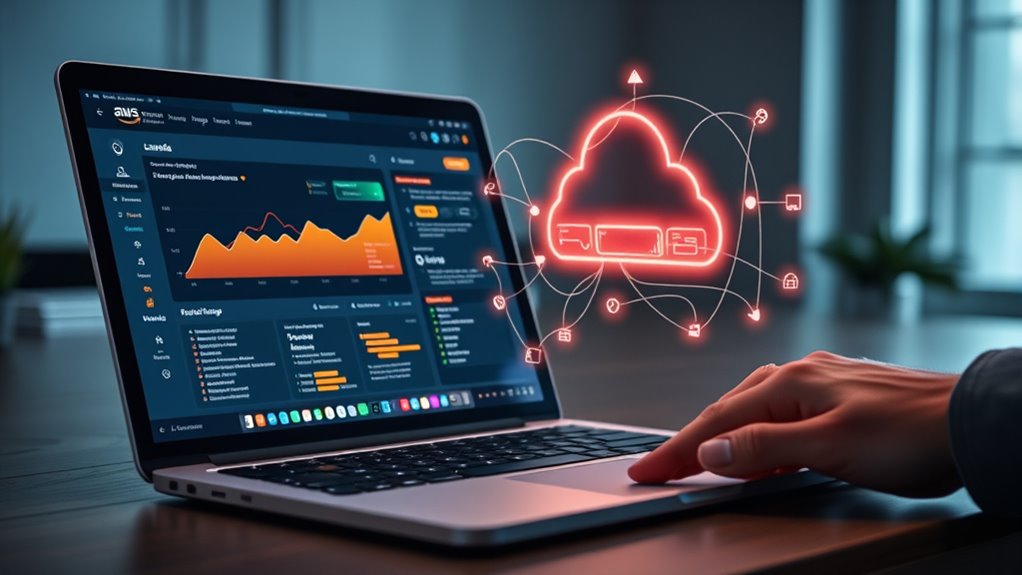Event-driven automations using AWS Lambda let you build responsive, scalable applications that react instantly to events from services like S3, DynamoDB, or API Gateway. You set up triggers, manage data flow securely, and design efficient functions to automate tasks such as data processing, resource management, or alerts. Monitoring and troubleshooting guarantee your automation remains reliable. Keep exploring how these best practices can help you optimize your cloud workflows effectively and securely.
Key Takeaways
- AWS Lambda enables real-time, event-driven automation by responding to triggers from services like S3, DynamoDB, and API Gateway.
- Proper configuration of triggers and permissions ensures seamless, secure automation across AWS services.
- Automations can be optimized by modular Lambda functions, environment variables, and cost-effective resource settings.
- Monitoring with CloudWatch and logs helps troubleshoot, refine, and maintain reliable event-driven workflows.
- Industry best practices include security, performance optimization, and leveraging insights for scalable, responsive automation.
Understanding the Core Principles of Event-Driven Architecture

Event-driven architecture (EDA) is a design approach that enables your applications to respond to events in real-time. At its core, understanding event-driven principles helps you build systems that are scalable, flexible, and reactive. These principles emphasize decoupling components so they can operate independently, reacting only when relevant events occur. You’ll focus on architecture fundamentals like event producers, event consumers, and messaging channels, which facilitate seamless communication. By designing with EDA principles in mind, you ensure your system can handle high volumes of events efficiently, without bottlenecks. This approach promotes agility, allowing your applications to adapt quickly to changing conditions or new data streams. Mastering these core concepts is essential before implementing event-based triggers with AWS Lambda. Additionally, understanding how different components like message queues and projectors for visual output interact enables more effective system design.
Setting Up AWS Lambda for Event-Based Triggers

To set up AWS Lambda for event-based triggers, you first need to identify the sources that will generate the events your function should respond to, such as S3 buckets, DynamoDB tables, or API Gateway endpoints. Once identified, configure the trigger within the AWS Management Console or using Infrastructure as Code tools like CloudFormation. Guarantee your Lambda functions follow cloud security best practices by setting proper permissions and using IAM roles. This minimizes potential vulnerabilities and maintains compliance. Also, optimize costs by selecting appropriate memory and timeout settings, and by leveraging event filtering to reduce unnecessary invocations. Proper setup ensures your automation runs efficiently, securely, and cost-effectively, helping you build scalable, responsive workflows that align with best practices in cloud security and cost management****.
Integrating AWS Services for Seamless Automation

You can create powerful automations by integrating AWS services to work together smoothly. Configuring event triggers guarantees your Lambda functions respond correctly, while managing cross-service data flow keeps information synchronized. Automated response handling then allows your system to act swiftly on events, reducing manual effort and increasing efficiency. Recognizing and interpreting patterns in event occurrences can further optimize your automation strategies by aligning actions with specific triggers. Recognizing and interpreting patterns enhances the responsiveness and relevance of your automations.
Event Trigger Configuration
How can you guarantee your AWS Lambda functions trigger seamlessly across various AWS services? The key lies in proper event trigger configuration. When setting up your Lambda, focus on the event trigger configuration to ensure it responds correctly to specific events from services like S3, DynamoDB, or SNS. During lambda function setup, select the appropriate trigger type and specify parameters such as bucket names, table streams, or topic ARNs. This precise configuration ensures your Lambda executes automatically whenever the event occurs. Keep in mind, each service has its own trigger options, so understanding these options helps optimize responsiveness. With careful event trigger configuration, you create a reliable, automated workflow that reacts instantly to cloud events, keeping your application responsive and efficient. Proper monitoring tools can help verify that triggers are functioning as intended.
Cross-Service Data Flow
Efficient automation across AWS services depends on orchestrating data flow seamlessly between them. To achieve this, you need to focus on data serialization, converting data into formats like JSON or Protocol Buffers for reliable transmission. Proper data serialization guarantees that information remains intact and easily interpretable across different services. Additionally, security protocols are crucial; encrypt data both in transit and at rest to prevent unauthorized access. Using AWS services like KMS for encryption and IAM policies for access control helps safeguard your data during flow. By integrating these practices, you guarantee smooth, secure communication between services such as S3, DynamoDB, and Lambda, enabling your event-driven automations to operate efficiently and securely without interruption. Incorporating data-driven strategies can further optimize automation performance by providing measurable results and insights.
Automated Response Handling
Have you ever wondered how AWS services can work together instantly to respond to events? Automated response handling leverages AWS Lambda to coordinate notifications management across various services. When an event occurs, Lambda can trigger notifications via SNS or SES, alerting you or other systems immediately. This seamless integration ensures rapid, automated reactions to security incidents or operational changes. Additionally, understanding cybersecurity vulnerabilities during outages helps in designing more resilient automation strategies. Security considerations are vital; you must restrict permissions and encrypt sensitive data to prevent unauthorized access. Properly managing notifications prevents alert fatigue, keeping your team informed without overwhelming them. By combining AWS services in this way, you create an efficient, secure, and responsive automation framework that reacts instantly to real-time events, streamlining your operations and enhancing overall security posture.
Practical Use Cases for Lambda-Driven Automations

You can use Lambda-driven automations for real-time data processing to quickly analyze and respond to incoming information. Automated resource management helps you optimize cloud assets, reducing costs and improving efficiency. These use cases demonstrate how Lambda can streamline operations and enhance responsiveness across your environment. Implementing financial analysis automations can also aid in monitoring and managing costs related to cloud resource usage.
Real-Time Data Processing
Real-time data processing is at the heart of many modern automation workflows, allowing systems to respond instantly to new information. When you use Lambda for this purpose, you can analyze streaming data, trigger alerts, or update dashboards immediately. To guarantee data security, you can implement encryption and strict access controls. Cost optimization is also essential; Lambda charges are based on usage, so processing only relevant data minimizes expenses. Additionally, implementing advanced segmentation techniques can enhance targeting accuracy and efficiency. Here’s a quick comparison:
| Feature | Benefits |
|---|---|
| Data security | Protects sensitive information during processing |
| Cost optimization | Reduces costs by processing only necessary data |
Automated Resource Management
Automated resource management with AWS Lambda streamlines operations by dynamically provisioning, scaling, and decommissioning cloud resources as needed. This approach optimizes resource allocation and enhances event orchestration. You can:
- Trigger Lambda functions based on specific events, enabling immediate response to workload changes.
- Automatically scale resources up or down, ensuring efficient handling of fluctuating traffic.
- Decommission unused resources, reducing costs and maintaining a lean cloud environment.
- Incorporate farmhouse bedroom design principles into your infrastructure to create a comfortable and cohesive environment.
Best Practices for Designing Efficient Lambda Functions

Designing efficient Lambda functions requires careful attention to resource management and execution patterns. To handle scalability challenges, optimize your code to run quickly and minimize cold starts by keeping functions lightweight. Use environment variables and external storage for configuration data instead of hardcoding. Be mindful of security considerations by implementing the principle of least privilege, encrypting sensitive data, and applying proper IAM roles. Break complex tasks into smaller, modular functions to improve maintainability and reduce execution time. Avoid unnecessary dependencies and libraries that can increase startup latency. Test your functions under different loads to identify bottlenecks and optimize accordingly. Additionally, understanding industry trends helps in adopting the latest best practices for serverless architecture. By focusing on these best practices, you’ll create Lambda functions that are both scalable and secure, ensuring reliable event-driven automation.
Monitoring, Troubleshooting, and Optimizing Lambda Automations

To guarantee your Lambda automations run smoothly and efficiently, it’s crucial to implement robust monitoring and troubleshooting practices. Start by setting up CloudWatch to track metrics like invocation errors, duration, and security vulnerabilities. This helps you quickly identify issues and prevent security risks. Next, analyze logs regularly to pinpoint root causes and optimize your functions for cost efficiency. Use detailed insights to reduce unnecessary invocations, lowering expenses. Additionally, understanding sound healing science can offer insights into how auditory stimuli may influence stress levels, which can be useful when designing user experiences around Lambda functions. Finally, implement alarms for anomalies so you can react swiftly to security threats or performance drops. By continuously monitoring, troubleshooting, and refining your automations, you ensure they stay secure, cost-effective, and reliable. This proactive approach minimizes downtime and maximizes the value of your serverless architecture.
Frequently Asked Questions
How Do I Manage Lambda Function Costs Effectively?
To manage Lambda function costs effectively, you should focus on cost optimization strategies and budget monitoring. Regularly review your usage patterns and adjust your functions to run only when necessary. Set up alerts for budget thresholds to prevent overspending. Use AWS Cost Explorer and AWS Budgets to track expenses, and optimize your code to reduce execution time. Implementing these practices helps you control costs while maintaining performance.
What Security Measures Should I Implement for Lambda Triggers?
Think of securing your Lambda triggers like guarding a fortress gate. You should implement strict access control, ensuring only authorized users can invoke functions. Additionally, validate triggers meticulously to prevent malicious inputs. Use IAM roles for precise permissions and enable trigger-specific validation, whether through API Gateway or other services. These steps help protect your environment, reduce risks, and keep your automation resilient—acting as your digital shield in the cloud.
Can Lambda Automate Cross-Region Workflows?
You can use AWS Lambda to automate cross-region workflows by integrating it with services like Amazon S3, DynamoDB, or SNS, enabling cross-region replication and multi-account automation. By configuring Lambda functions to trigger across different regions and accounts, you guarantee data synchronization, backup, and disaster recovery. This setup helps improve resilience and operational efficiency, allowing you to manage complex, distributed processes seamlessly across multiple AWS environments.
How Do I Handle State Management in Serverless Automations?
Think of your serverless automation as a delicate dance where every step matters. To handle state management, you need reliable state persistence, ensuring your workflows don’t stumble. Use services like DynamoDB or S3 for workflow orchestration, keeping track of progress and data. This way, your automations stay synchronized, resilient, and able to recover from interruptions, turning chaos into harmony and keeping your processes flowing smoothly.
What Are the Limitations of AWS Lambda for Event-Driven Tasks?
You may face limitations with AWS Lambda for event-driven tasks, especially regarding scalability challenges and debugging complexities. As your workload grows, Lambda’s execution limits and cold start times can hinder performance. Debugging can also be tricky due to its stateless nature and limited logging, making it harder to troubleshoot issues. Recognizing these constraints helps you plan effectively and consider complementary solutions for more complex or scalable automation needs.
Conclusion
Think of AWS Lambda as the conductor of your automation orchestra, seamlessly coordinating different services to create harmony. When you master event-driven architecture, each trigger becomes a musical note, working together to produce a symphony of efficiency. Stay attentive, optimize your functions, and troubleshoot promptly. With the right rhythm, your automations will perform flawlessly, turning complex tasks into a well-coordinated melody that elevates your cloud experience.









